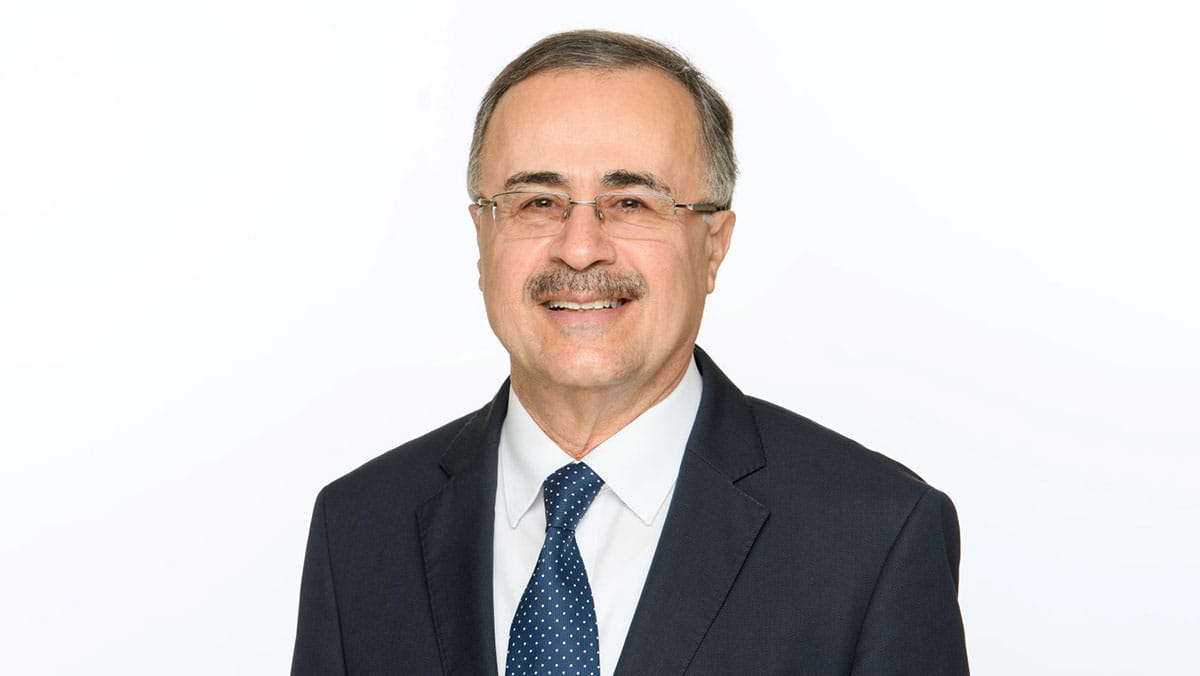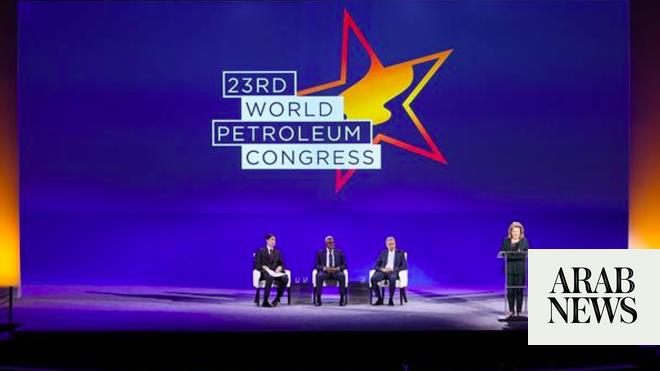
OUR BUSINESS
Your Royal Highness, Your Excellencies, Ladies and Gentlemen, good morning.
Let me first thank our Canadian hosts for their superb hospitality here in Calgary. I would also like to thank Pedro for his kind words, and congratulate him and his team for bringing our industry back to Canada’s energy capital for the first time in a generation.
And I am truly humbled to receive the WPC’s Dewhurst Award. However, without the support of family and friends, teachers and leaders, peers and partners, such recognition would be impossible.
I also want to thank our Minister of Energy, His Royal Highness, Prince Abdulaziz bin Salman bin Abdulaziz, who is here today, for his guidance and support over the years. And I especially want to pay tribute to the men and women of Aramco.
When we were handed a prominent role in Saudi Vision 2030, including a successful IPO, they delivered. When our facilities came under attack, and with the world watching, they delivered. And when our entire industry had to deal with down cycles, COVID and a full-blown energy crisis, they delivered!
So this is their Award too.
Over the years, I have seen many exciting changes – at Aramco and across the industry. But some things have come full circle since I joined Aramco in 1982.
Back then, the talk was of peak oil supply. This was seriously flawed because it ignored a key principle of markets: as long as the economics were there so was the incentive to discover and recover additional oil.
And it did not anticipate our industry’s ability to innovate with horizontal wells; hydraulic fracturing; 3D seismic; and offshore technologies, especially deep-water drilling.
More recently the talk has shifted to peak oil demand. But this notion is also wilting under scrutiny because it is mostly being driven by policies, rather than the proven combination of markets, competitive economics, and technology.
With these thoughts in mind, I want to address the theme of this conference: “the path to net-zero”.
I see it in two parts: our climate goals, and how we achieve them. On the goals, there is widespread commitment (including across our industry) to reaching a global net-zero economy.
And everyone on the planet has a vested interest in the Paris Agreement’s ultimate goal of holding the increase in global average temperature rise to well below two degrees, even to 1.5 degrees.
But in terms of how we get there, I see many shortcomings in the current transition approach that can no longer be ignored. To begin with, until recently the dominant narrative was based on an aggregation of unrealistic scenarios and assumptions.
The result has been an equally unrealistic target energy mix and timeline. Lately, there has been a welcome shift in the narrative toward the energy mix and timeframe that logic and data strongly suggest will actually materialize.
But the shift needs to become more meaningful. Then there is the sheer scale of the challenge. We are talking about the complete transformation of a $100 trillion global economy today.
One that is likely to roughly double in size by 2050, with close to an additional 2 billion energy consumers. In short, the re-invention of our entire energy-based way of life in less than 30 years.
Let us be inspired by that, but understand it means making history. And so far the reality on the ground is that despite concerted efforts to move to alternatives, global coal consumption is at record levels, exceeding 8 billion tons, with demand still robust.
In oil, one widely-publicized scenario calls for global demand to fall by more than 25 million barrels per day by 2030. Yet oil consumption is projected to approach 103 million barrels per day in the second half of this year, which would be a record.
Meanwhile gas has become an increasingly important bridge fuel, with access to adequate and affordable supplies a geopolitical hotspot. By contrast, despite record renewables growth, wind and solar combined still only account for about 5% of global primary energy consumption today.
Then there is Green Hydrogen.
Today, “production” costs are in the range of $200 to $400 per barrel of oil equivalent, which is why commercial offtake agreements are hard to come by. I want to stress that alternatives like wind, solar, and hydrogen are considered to be the bedrock of transition.
But these powerful numbers show that phasing out conventional energy prematurely could put energy security and affordability priorities at risk. As the recent energy crisis has shown, compounded by the conflict in Ukraine, the world wobbles if these realities are ignored or wished away. And the public anger we have already seen could ultimately derail climate ambitions and actions themselves.
In fact, the current transition shortcomings are already causing mass confusion across industries that produce and/or rely on energy. Long-term planners and investors do not know which way to turn.
It is increasing the risk of acute supply-demand imbalances in conventional energy, and therefore an even more serious energy crisis where countries and people, not just assets, are stranded.
Furthermore, while much of the Global North is focusing on environmental sustainability, the priority for many in the Global South is economic survival. Transition planning has not sufficiently recognized this clear need for distinctive solutions, and a widening divide is an inevitable result.
However, there have been some positive consequences. In particular, we are starting to see a much healthier debate.
Influential world leaders increasingly talk about solutions that reflect different economic and energy situations. They speak of building the new before discarding the old. And they call for a pragmatic and proportionate way of getting there without burdening people with additional costs.
This reflects a growing recognition among policymakers, businesses, and people around the world that alternatives are not yet ready. And that the only plausible way forward is to address transition shortcomings and their consequences head-on. This momentum tells me the world is ready for a plan that works.
Let us be clear: there is NO quick fix.
But I believe we can achieve our shared climate goals, and avoid a new crisis, if ALL stakeholders work together in five strategic dimensions.
First, the world deserves a more realistic, more robust energy transition plan. One that clearly emphasizes the continued deployment of new energy while recognizing the continued need for conventional energy. Because all sources are needed to meet growing energy demand, adjusting the mix as we go according to experience and need.
For example, all shades of lower carbon hydrogen should be in the mix. This should also incentivize long-term investments in both new and conventional energy.
Second, with a better plan in place, those investments should include an intensified focus on innovation and technology to further reduce the carbon footprint of conventional energy. And our industry is committed to doing so, for example through the Oil and Gas Climate Initiative. We met our upstream methane intensity target years ahead of schedule, and are now aiming for near-zero upstream methane intensity by 2030.
Third, the “invisible fuel” of energy efficiency represents about 40% of emissions abatement needed by 2040. Yet this remains an under-utilized club in our golf bag; this has to change.
Fourth, the improved plan must give greater and more practical attention to the special situations and unique needs of lower income, developing countries. And without generous financial support from developed countries, the Paris Agreement targets are unlikely to be met.
Fifth, energy, including mobility, is clearly a vital sector. But there are vast climate protection opportunities in other sectors. Approaching them holistically could make climate protection efforts much more robust.
For example, the global food system accounts for up to a third of total GHG emissions. GHG emissions from livestock alone fall in the same range as the entire global transport sector!
Then we have the world’s forests which help combat global warming by removing CO2 from the atmosphere and storing it. In fact, recent research suggests forests absorb a net 7.6 billion metric tonnes of CO2 per year, which equates to about one and a half times the carbon emitted by the U.S. annually!
So forest conservation and re-forestation is a potent combination that can significantly enhance the world’s carbon sequestration capacity. In fact, this has become an important pillar of net-zero ambitions for many in our industry, including Aramco. Equally, I think it is time the world also gave greater attention to man-made carbon sinks, particularly CCS.
It could be deployed in a variety of sectors, including hard-to-abate industries, power plants using coal and gas, biomass-based power stations, and even through Direct Air Capture. The potential climate gains would likewise be large.
One scenario suggests that integrating CCS with cement plants might capture and store about 95% of CO2 emissions from the entire sector by 2050. But some estimates suggest that CCS capacity needs to grow 120 times by 2050 for countries to meet their net-zero commitments.
CCS can no longer be the bridesmaid of transition; it is central to our industry’s future, but even more importantly global climate goals. Last but not least, steel, aluminum, and cement account for about 20% of global CO2 emissions.
In fact, if the cement industry were a country, it would be the third-largest emitter of CO2!
Yet the enormous impact that growth in material use will have on global GHG emissions has been largely missing from the debate. So complementing these conventional materials with more durable and sustainable ones through a materials transition, in parallel with the energy transition, is essential.
And I believe it will be the next big thing for the petroleum and chemical industries, working together.
Ladies and Gentlemen, there never was a quick and easy single path to global climate goals. It is more like an epic voyage across a vast ocean.
We know the destination, and the whole world has already left port. But the fleet is scattered and drifting.
It is time to reunite around a more robust transition, with winds of realism in our sails, reflecting the multi-source, multi-speed, and multi-dimensional approach I have outlined this morning.
Together with our industry’s reputation for delivering, I believe we can all reach the far shore.
And make future generations proud we made history, when history needed making.
Thank you.










